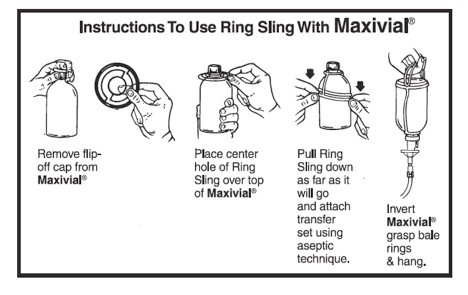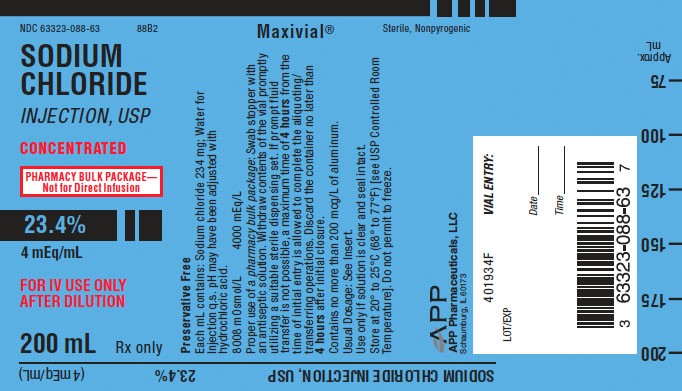Sodium Chloride
Sodium Chloride Injeciton USP
FULL PRESCRIBING INFORMATION: CONTENTS*
- SODIUM CHLORIDE DESCRIPTION
- CLINICAL PHARMACOLOGY
- SODIUM CHLORIDE INDICATIONS AND USAGE
- SODIUM CHLORIDE CONTRAINDICATIONS
- WARNINGS
- PRECAUTIONS
- SODIUM CHLORIDE ADVERSE REACTIONS
- OVERDOSAGE
- SODIUM CHLORIDE DOSAGE AND ADMINISTRATION
- DIRECTIONS FOR PROPER USE OF PHARMACY BULK PACKAGE
- HOW SUPPLIED
FULL PRESCRIBING INFORMATION
23.4%
4 mEq/mL
CONCENTRATED
|
PHARMACY BULK PACKAGE— Not for Direct Infusion |
CONCENTRATED SOLUTIONS FOR USE ONLY AFTER DILUTION WITH COMPATIBLE IV FLUIDS TO CORRECT SODIUM DEFICIENCY WHEN ORAL REPLACEMENT IS NOT FEASIBLE.
SODIUM CHLORIDE DESCRIPTION
Sodium Chloride Injection, USP is a sterile, nonpyrogenic, concentrated solution for intravenous administration ONLY AFTER DILUTION to replenish electrolytes. The preparation contains 4 mEq/mL (23.4%) sodium chloride, in Water for Injection. The solution contains no bacteriostat, antimicrobial agent or added buffer; pH of the solution ranges from 4.5 to 7.0. Each mL contains: Sodium chloride 234 mg; Water for Injection q.s. pH may have been adjusted with hydrochloric acid. The osmolar concentration of the 4 mEq/mL solution is 8 mOsmol/mL (calculated). Sodium chloride is chemically designated NaCI, a white crystalline compound freely soluble in water.
A pharmacy bulk package is a sterile dosage form containing many single doses. The contents are intended for use in a pharmacy admixture program and are restricted to the preparation of admixtures for IV infusion.
CLINICAL PHARMACOLOGY
Sodium chloride in water dissociates to provide sodium (Na+) and chloride (CI—) ions.
These ions are normal constituents of the body fluids (principally extracellular) and are essential for maintaining electrolyte balance.
Sodium is the principal cation of extracellular fluid. It comprises more than 90% of the total cations at its normal plasma concentration of approximately 142 mEq/L. While the sodium ion can diffuse across cell membranes, intracellular sodium is maintained at a much lower concentration than extracellular sodium through the expenditure of energy by the cell (so-called ‘‘sodium cation pump’’). Loss of intracellular potassium ion is usually accompanied by an increase in intracellular sodium ion.
When serum sodium concentration is low, the secretion of antidiuretic hormone (ADH) by the pituitary is inhibited, thereby preventing water reabsorption by the distal renal tubules.
On the other hand, adrenal secretion of aldosterone increases renal tubular reabsorption of sodium in an effort to reestablish normal serum sodium concentration.
Chloride (CI—) has an integral role in buffering action when oxygen and carbon dioxide exchange occurs in the red blood cells.
The distribution and excretion of sodium (Na+) and chloride (CI—) are largely under the control of the kidney which maintains a balance between intake and output.
SODIUM CHLORIDE INDICATIONS AND USAGE
Sodium Chloride Injection, USP is indicated for parenteral restoration of sodium ion in patients with restricted oral intake. Sodium replacement is specifically indicated in patients with hyponatremia or low salt syndrome. Sodium chloride injection may also be added to compatible carbohydrate solutions such as dextrose in water to provide electrolytes.
SODIUM CHLORIDE CONTRAINDICATIONS
Sodium chloride injection is contraindicated in patients with hypernatremia or fluid retention.
WARNINGS
WARNING: This product contains aluminum that may be toxic. Aluminum may reach toxic levels with prolonged parenteral administration if kidney function is impaired. Premature neonates are particularly at risk because their kidneys are immature, and they require large amounts of calcium and phosphate solutions, which contain aluminum.
Research indicates that patients with impaired kidney function, including premature neonates, who receive parenteral levels of aluminum at greater than 4 to 5 mcg/kg/day accumulate aluminum at levels associated with central nervous system and bone toxicity. Tissue loading may occur at even lower rates of administration.
Solutions containing sodium ions should be used with great care, if at all, in patients with congestive heart failure, severe renal insufficiency and in clinical states in which there exists edema with sodium retention.
In patients with diminished renal function, administration of solutions containing sodium may result in sodium retention.
The intravenous administration of this solution (after appropriate dilution) can cause fluid and/or solute overloading resulting in dilution of other serum electrolyte concentrations, overhydration, congested states or pulmonary edema.
Excessive administration of potassium free solutions may result in significant hypokalemia.
PRECAUTIONS
Do not use unless the solution is clear and seal is intact.
Sodium chloride injection must be diluted before infusion to avoid a sudden increase in the level of plasma sodium. Too rapid administration should be avoided.
Special caution should be used in administering sodium containing solutions to patients with severe renal impairment, cirrhosis of the liver, cardiac failure, or other edematous or sodium-retaining states.
Clinical evaluation and periodic laboratory determinations are necessary to monitor changes in fluid balance, electrolyte concentrations, and acid-base balance during prolonged parenteral therapy or whenever the condition of the patient warrants such evaluation.
Caution must be exercised in the administration of parenteral fluids, especially those containing sodium ions, to patients receiving corticosteroids or corticotropin.
Pregnancy
Teratogenic Effects: Pregnancy Category C— Animal reproduction studies have not been conducted with sodium chloride. It is also not known whether sodium chloride can cause fetal harm when administered to a pregnant woman or can affect reproduction capacity. Sodium chloride should be given to a pregnant woman only if clearly needed.
SODIUM CHLORIDE ADVERSE REACTIONS
None known.
OVERDOSAGE
In the event of overhydration or solute overload, reevaluate the patient and institute appropriate corrective measures. (See WARNINGS and PRECAUTIONS .)
SODIUM CHLORIDE DOSAGE AND ADMINISTRATION
Sodium chloride injection is administered intravenously only after addition to a larger volume of fluid.
The dose, dilution and rate of injection are dependent upon the individual needs of each patient.
All or part of the contents of one or more additive containers may be added to an intravenous solution container. Concentrations of up to 5% sodium chloride have been administered.
DIRECTIONS FOR PROPER USE OF PHARMACY BULK PACKAGE
Pharmacy Bulk Packages are for use in a pharmacy admixture service only in a laminar flow hood. They should be inserted into the ring sling (plastic hanging device) provided and suspended as a unit in the laminar flow hood. The container closure should be penetrated only one time utilizing a suitable sterile dispensing set which allows measured distribution of the contents. Swab vial stopper with an antiseptic solution. Insert the dispensing set into the vial using aseptic technique. (See graphic illustration below.)

Once the sterile dispensing set has been inserted into the container, withdrawal of the contents should be accomplished without delay. However, if this is not possible, a maximum time of 4 hours from the initial entry may be allowed to complete fluid aliquoting/transferring operations. Discard the container no later than 4 hours after initial closure puncture.
Parenteral drug products should be inspected visually for particulate matter and discoloration prior to administration, whenever solution and container permit. (See PRECAUTIONS .)
HOW SUPPLIED
Sodium Chloride Injection, USP is available in flip-top glass vials.
|
Product No. |
NDC No. |
% NaCI |
Na+ mEq/mL |
CI – mEq/mL |
mOsmol/ mL |
Fill Volume mL |
|
88B1 |
63323-088-61 |
23.4 |
4 |
4 |
8 |
100 |
|
88B2 |
63323-088-63 |
23.4 |
4 |
4 |
8 |
200 |
Packaged in 20 and 10 vials per tray, respectively.
Store at 20° to 25°C (68° to 77°F) [see USP Controlled Room Temperature]. Do not permit to freeze.

45874E
Revised: March 2008
PACKAGE LABEL - PRINCIPAL DISPLAY - Sodium Chloride 200 mL Vial Label
NDC 63323-088-63
88B2
Sodium Chloride Injection, USP
Concentrated
PHARMACY BULK PACKAGE - Not for Direct Infusion
23.4% (4 mEq/mL)
For IV Use Only After Dilution
Rx only
200 mL

Sodium ChlorideSodium Chloride INJECTION, SOLUTION
| |||||||||||||||||||||||||||||||||||||||||||||||||||||||||||